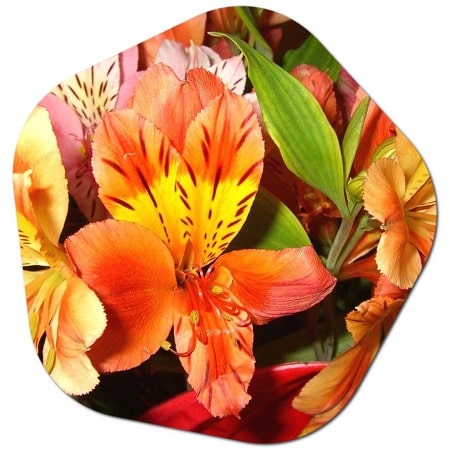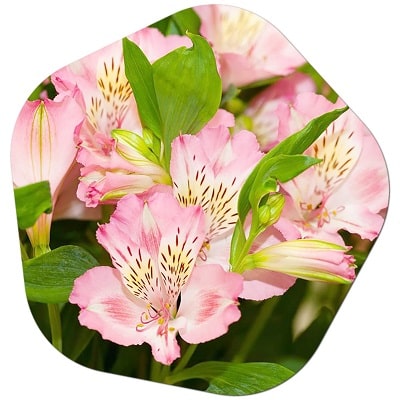It can be used more as a cut flower. The garden is taller than Peruvian lilies. Alstroemeria is native to South America and is also called the inca lily. Alstroemeria is a species in the Alstroemeriaceae family. The roots of Alstroemeria aurea ‘Orange King’ are very fragile and go quite deep. Alstroemeria aurea ‘Orange King’ prefers warm, sunny and fairly dry locations. The stems of the Inca lily remain erect. The flowers are very suitable as cut flowers and last a long time. Flowering period June – July Flower color: orange Scented flower: no Soil type: normal / dry Height 90 cm Location: sun or partial shade Robustness -20 ºC.
Depending on seasonal and climatic conditions, there may be changes in the physical structure of the products.
Alstroemeria, commonly known as the Peruvian lily or lily of the Incas, can be grown in various regions of the United States, especially in areas with temperate climates. This perennial flowering plant is known for its vibrant and colorful flowers. Here are some general guidelines on where Alstroemeria can grow in the United States:

- Pacific Northwest:
- Alstroemeria tends to thrive in the mild and moist climates of the Pacific Northwest. States like Washington and Oregon, with their moderate temperatures and regular rainfall, provide suitable conditions for the cultivation of Alstroemeria.
- California:
- Alstroemeria is well-suited to the Mediterranean climate of California. It can be grown in both northern and southern parts of the state, taking advantage of the dry summers and mild, wet winters.
- Mountain West:
- Some areas in the Mountain West region, particularly those with moderate temperatures and well-draining soil, may support the growth of Alstroemeria. This includes parts of Colorado, Idaho, and Montana.
- Southwestern United States:
- In regions with a semi-arid climate and well-drained soil, such as parts of Arizona and New Mexico, Alstroemeria can be cultivated successfully.
- Gulf Coast States:
- Alstroemeria may be grown in some parts of the Gulf Coast states, such as Louisiana and parts of Texas, where the climate is relatively warm and humid.
It’s important to note that Alstroemeria can be grown in a wider range of climates as long as the soil is well-draining. The plant prefers a location with plenty of sunlight, but it can tolerate some shade. Additionally, Alstroemeria is often cultivated as an ornamental plant in gardens and can be found in various regions where gardeners appreciate its attractive flowers and relatively low maintenance requirements.
If you’re considering growing Alstroemeria, it’s a good idea to check with local nurseries or gardening experts for advice specific to your region and to ensure that you choose the appropriate variety for your climate.
What country is Alstroemeria from?
Alstroemeria, commonly known as the Peruvian lily or lily of the Incas, is native to South America. It is specifically native to several countries in the western part of the continent, including:

- Peru: The name “Peruvian lily” reflects the fact that Alstroemeria is native to Peru. It is found in various regions of the country, growing in diverse habitats ranging from coastal areas to mountainous regions.
- Chile: Alstroemeria is also native to Chile, where it can be found in different ecological zones, from the coast to the Andes mountains.
Alstroemeria has become a popular ornamental plant worldwide, appreciated for its colorful and long-lasting flowers. It has been cultivated in many countries beyond its native range and is commonly grown in gardens and used in floral arrangements. As a result, Alstroemeria can now be found in various parts of the world, not just in South America. Where can Alstroemeria be found? >>
Where does Alstroemeria grow best?
Alstroemeria, commonly known as the Peruvian lily or lily of the Incas, grows best in regions with temperate climates that mimic its native South American habitat. Here are some key factors for optimal Alstroemeria growth:
- Climate:
- Alstroemeria thrives in temperate climates with mild temperatures. It prefers temperatures ranging from 60 to 75°F (15 to 24°C) during the day and slightly cooler temperatures at night.
- Sunlight:
- Alstroemeria prefers full sun to partial shade. In regions with intense summer heat, providing some afternoon shade can be beneficial.
- Soil:
- Well-draining soil is crucial for Alstroemeria. It doesn’t tolerate waterlogged conditions, so soil should be loose and well-aerated. A slightly acidic to neutral soil pH is suitable.
- Watering:
- Keep the soil consistently moist but not waterlogged. Alstroemeria does not like to dry out completely, so regular watering is important, especially during dry periods.
- Mulching:
- Applying a layer of mulch around the plants helps retain soil moisture, suppress weeds, and regulate soil temperature.
- Air Circulation:
- Good air circulation around the plants is important to prevent fungal diseases. Avoid overcrowding and provide space between plants.
- Fertilization:
- Alstroemeria benefits from regular fertilization during the growing season. Use a balanced, all-purpose fertilizer and follow the recommended application rates.
- Winter Care:
- In regions with colder winters, provide some protection during frost. Mulch around the base of the plants can help insulate the roots.
Given these conditions, Alstroemeria can be successfully grown in a variety of gardens, including those in Mediterranean climates, coastal areas, and regions with moderate temperatures and well-draining soil. It is commonly used in flower beds, borders, and cut flower gardens. When planting Alstroemeria, it’s advisable to choose the right cultivar for your specific climate and follow proper care guidelines for the best results.
